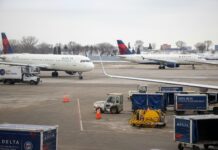Las Vegas, a city known for its vibrant nightlife, entertainment, and casinos, has been historically spared from the devastation of wildfires that have plagued other areas of the country. However, recent events in nearby Los Angeles have raised concerns about the potential risks that Las Vegas residents face when it comes to wildfires.
In Los Angeles, a series of seven wildfires wreaked havoc, claiming the lives of at least 29 people and causing economic losses of up to $275 billion. These fires were fueled by powerful winds, abundant vegetation acting as fuel, and a lack of rainfall that dried out the soil—creating a perfect storm for widespread destruction.
While Las Vegas may have physical advantages that could mitigate the risk of large-scale wildfires, experts warn that the threat should not be dismissed. Billy Samuels, the acting fire chief of the Clark County Fire Department, emphasized the importance of preparedness and vigilance in the face of changing climate conditions and insurance challenges.
Tools developed by both public and private sectors offer insights into the potential wildfire risks faced by Las Vegas residents. Companies like First Street and real estate brokerage Redfin have identified properties in Clark County at risk of wildfires over the next 30 years. Climate change exacerbates these risks, as drier and hotter conditions increase the likelihood of fire-friendly weather patterns.
Despite risk assessments and data analysis, wildfires are unpredictable and can strike at any time. Kacey KC, Nevada’s fire warden and state forester, noted that wildfires do not discriminate based on risk assessments—if the conditions are right, a spark can set off a chain reaction of destruction. Factors like wind patterns and humidity levels play a crucial role in determining the path of a wildfire.
Many Nevadans have viewed wildfires as a concern for rural areas or regions like Mount Charleston, but history tells a different story. While the Las Vegas Valley has mostly been spared from significant wildfire impacts, the Carpenter 1 fire in 2013 burned thousands of acres in the Spring Mountains due to extreme weather conditions and topographical features.
Mount Charleston’s densely wooded landscape presents unique challenges for fire prevention efforts. Nevada has identified it as a priority area for vegetation management to reduce fire risks. Emergency response in areas like Mount Charleston can be complicated by limited road access and communication breakdowns during crises.
Despite these challenges, Las Vegas benefits from certain factors that reduce wildfire risks. The region’s hot and dry climate limits vegetation growth, and the topography is less conducive to large-scale fires compared to rural areas. Collaboration between public and private partners enhances the community’s preparedness and response capabilities.
Efforts are underway to enhance Nevada’s resilience to wildfires through multi-agency collaboration and legislative measures. A proposed bill in the Nevada Legislature aims to leverage existing interstate fire compacts to improve emergency response. Water availability in the Las Vegas Valley is a crucial asset in firefighting efforts, with reservoirs holding a billion gallons of water and a gravity-fed system ensuring continuous supply even during emergencies.
To empower residents in wildfire preparedness, Clark County officials recommend downloading apps like the Southern Nevada Community Preparedness App and CodeRED for timely notifications and alerts. Establishing a communication plan, preparing emergency kits, and staying informed are essential steps for residents to safeguard themselves and their families.
As wildfires continue to pose a threat to communities across the West, Nevada remains vigilant in its efforts to mitigate risks and protect its residents. With a proactive approach to prevention and response, Las Vegas stands ready to face the challenges of an evolving climate and landscape. In the face of uncertainty, preparedness is key to ensuring the safety and well-being of all residents.











